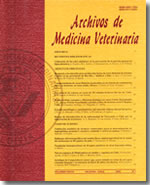Epidemiological and analytical aspects of bovine abortion syndrome
Main Article Content
Abstract
Bovine abortion is a limiting factor for the dairy sector, because it causes a decrease in milk production and the potential number of replacements of the herd, and also it constitutes a challenge for the veterinary profession. The objective of this paper is to review the epidemiology and different ways of analyzing the Bovine Abortion Syndrome (BAS). This review is divided in two parts; the first one presents an overview of the epidemiology, impact of the disease and risk factors; the second one presents some methodologies aimed to quantify and analyze BAS frequency and surveillance systems. Many differences can be found between the studies that analyze bovine abortion, the same happens with the way of calculating epidemiological indicators and definitions of important events. Also there are important differences regarding the subject in terms of presentation, methods of calculation of risk factors and especially the definition of events of importance. It is necessary to make a clear distinction between factors at animal and herd level, which could be associated with different production systems. In Chile, further investigation on BAS is needed in order to design more realistic and efficient control programs since risk factors reported in other countries could not necessarily be extrapolated to our local situation.

